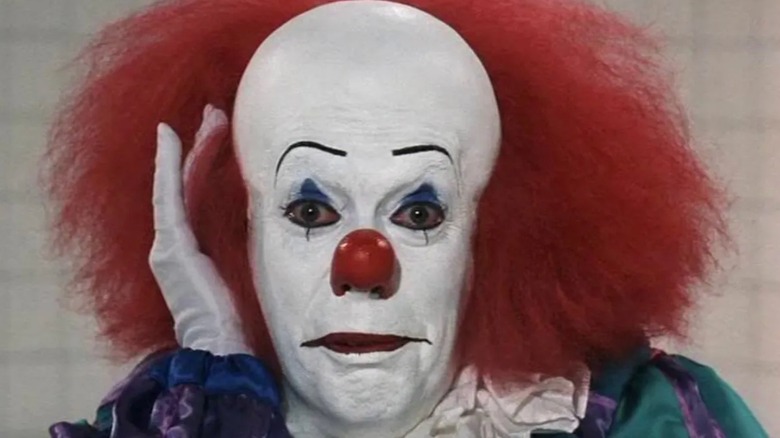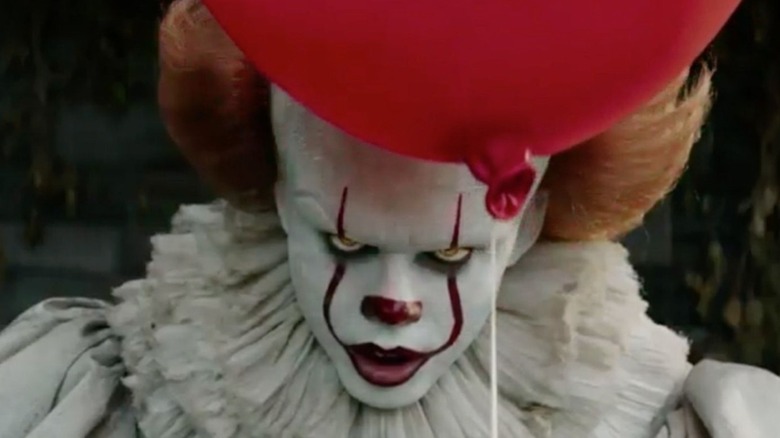Why George Romero Backed Out Of Directing ABC's Adaptation Of Stephen King's IT
Most filmmakers inevitably end their careers with some unrealized projects. Adapting Stephen King's horror tome "IT" is one such effort for Cary Fukunaga, but also the late George Romero, godfather of the zombie movie.
The first "IT" adaptation was a 1990 TV mini-series, aired on ABC in two 90-minute episodes. Writer Lawrence D. Cohen, who previously adapted King's novel "Carrie" in 1976 for director Brian DePalma, wrote the script. Much of that script, though, was rewritten by director Tommy Lee Wallace. A friend and collaborator of John Carpenter, Wallace was an editor and production designer on the horror master's famous 1978 slasher "Halloween. Five years later, Wallace stepped up to direct "Halloween III: Season of the Witch." On "IT," Carpenter's understudy became Romero's.
In both the 2015 oral history "Back to Derry: An Oral History of 'Stephen King's IT'" and the 2021 making-of documentary "Pennywise: The Story of IT," Cohen discusses how Romero was the first director approached to make "IT." Romero was apparently a fan of the book, and he'd previously directed "Creepshow," a horror anthology penned by King.
So why didn't Romero's "IT" happen? The official story is that Romero had a scheduling conflict, but Cohen has speculated there was another reason. "IT" is over 1100 pages, and Cohen pitched the miniseries to run between eight and "ideally ten" hours. Then ABC "lost their nerve" about a commitment that big, Cohen told Yahoo, so the series was cut to the final runtime.
"Truthfully, I think getting only four hours instead of eight took the magic out of the project for [Romero]," Cohen continued. During his "Pennywise" interview, he also said: "I think the dream of what [Romero and I] had in mind was absolutely amazing, I just think we were about 20 years early in having it."
Both IT adaptations have struggled with the novel's length
One reason Wallace got the job was because he was also a writer, and the script needed revisions, according to Executive Producer Jim Green.
Wallace added in his own doc interview that he'd previously written synopses of manuscripts for agents, and so he "developed a knack for condensing novels." Wallace had to put those condensing talents to good use, and rework the second episode's script to more accurately adapt the book. He explained to Yahoo:
"Larry's script for Night 1 was just wonderful, well organized and cleverly structured into seven parts for seven characters. His script for Night 2 wasn't nearly as successful, in my opinion. For reasons of his own, he had completely moved away from the plotting of the book, and created a much smaller story, a very interior melodrama focusing on Beverly's husband as the ultimate bad guy."
"IT" follows the same characters in two different points of time. In Derry, Maine, several children are terrorized by a shapeshifting and child-eating monster that usually takes the form of Pennywise, the Dancing Clown (played with delightful, but scary, aplomb by Tim Curry in the 1990 miniseries). 27 years later, the surviving adults are drawn back to Derry when Pennywise comes out of hibernation and they face Its true form.
"IT" is long is because it's two stories in one. Neither four-hour long adaptation has quite managed to crack the dual structure like the book did. Wallace himself described "IT" episode 2 to Yahoo as only "a radical condensation of the novel." The Andy Muschietti-directed "IT" films cleanly bifurcate the stories; the first film follows the kids, the second film follows the adults. I can see why that sounded like a good choice, but as "IT Chapter Two" showed, it made the adult story into a disorganized slog.
If you want to do "IT" right, you'll have to make it as massive as Stephen King did.

